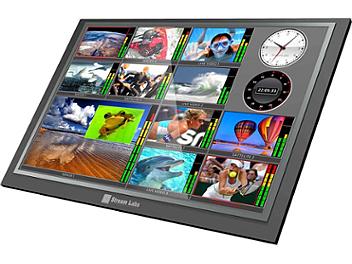Features
Monitoring features
* Multiple monitors support. Up to 4 monitors (up to 2 monitors in standard configuration) connection via VGA / DVI / HDMI interface to one Stream MultiScreen TS device;
* Vertical monitor arrangement support;
* Displaying monitor resolution can reach: 1600 x 1200 pixels (VGA output) or Full HD 1920 x 1080 pixels (HDMI / DVI-I (DVI-D) output);
* Final signal image display in standard television CVBS / S-Video / YUV format with 720 x 576 pixels resolution via video card output.
Core graphic design features
Extremely user-friendly Stream Client Manager application allows to create window configurations on any common PC. By using simple drag/drop action, built-in window layout editor helps you quickly create a necessary configuration, including signal control parameters assignment, amount of service information supplied to user, clock, timer and sound indicators display.
* Random video windows position and size. The maximum size a video window can reach is the full-screen monitor size. 16:9 frame ratio support;
* Unlimited number of layers for objects layout (windows, PPM, clocks, captions etc.);
* Brightness, contrast and saturation can be adjusted for every video window separately;
* Random audio PPM sound indicator position;
* Random window text (title) location, font, size and colour;
* Digital clock output with random position, font, size, colour and format of displayed data (time/date);
* Several analog clock types;
* Time zone adjustment for digital and analog clocks;
* Each system graphic object can have a specified outline (width, colour) and background (colour or image from file (bmp, tga, tif)).
Controlled signal parameters
"Video Server" system modules log the following events:
* Configuration change;
* Video Loss (video fallout / recovery);
* Audio Loss (basic audio stream fallout / recovery, level overshoot, low signal level);
* Frozen Video;
* Black Frame;
* Blocking Frame;
* GPI input change;
* Edh-errors reports for SDI-signal;
* Error in "continuity counter" field (for MPEG_TS source).
A schedule is composed to check the emergency alert response (with alarm analysis time span indication) with an option for custom response settings for each event.
The system operation log information is constantly updated and saved in client's (operator's) application, where it is also possible to make a query from any available "Video Server" module in order to obtain selective information at random system operation time range.
The system operation log features the following data:
* Time and date of alarm response start and end;
* Alarm signal duration;
* Alarm signal type;
* Multicast group name, IP address and port, PID stream;
* Server name, from which the alarm signal came;
* Service information: specified alarm response threshold values, signal operating values, etc.
The system can be configured for response to any emergency alert in the following ways:
* Visual (graphic): changing colour and frame width;
* Sounding an alarm signal via computer Sound Blaster;
* Alarm receipt confirmation by pressing a button or equivalent key in the client software;
* E-mailing a message to specified address.
* Multiple monitors support. Up to 4 monitors (up to 2 monitors in standard configuration) connection via VGA / DVI / HDMI interface to one Stream MultiScreen TS device;
* Vertical monitor arrangement support;
* Displaying monitor resolution can reach: 1600 x 1200 pixels (VGA output) or Full HD 1920 x 1080 pixels (HDMI / DVI-I (DVI-D) output);
* Final signal image display in standard television CVBS / S-Video / YUV format with 720 x 576 pixels resolution via video card output.
Core graphic design features
Extremely user-friendly Stream Client Manager application allows to create window configurations on any common PC. By using simple drag/drop action, built-in window layout editor helps you quickly create a necessary configuration, including signal control parameters assignment, amount of service information supplied to user, clock, timer and sound indicators display.
* Random video windows position and size. The maximum size a video window can reach is the full-screen monitor size. 16:9 frame ratio support;
* Unlimited number of layers for objects layout (windows, PPM, clocks, captions etc.);
* Brightness, contrast and saturation can be adjusted for every video window separately;
* Random audio PPM sound indicator position;
* Random window text (title) location, font, size and colour;
* Digital clock output with random position, font, size, colour and format of displayed data (time/date);
* Several analog clock types;
* Time zone adjustment for digital and analog clocks;
* Each system graphic object can have a specified outline (width, colour) and background (colour or image from file (bmp, tga, tif)).
Controlled signal parameters
"Video Server" system modules log the following events:
* Configuration change;
* Video Loss (video fallout / recovery);
* Audio Loss (basic audio stream fallout / recovery, level overshoot, low signal level);
* Frozen Video;
* Black Frame;
* Blocking Frame;
* GPI input change;
* Edh-errors reports for SDI-signal;
* Error in "continuity counter" field (for MPEG_TS source).
A schedule is composed to check the emergency alert response (with alarm analysis time span indication) with an option for custom response settings for each event.
The system operation log information is constantly updated and saved in client's (operator's) application, where it is also possible to make a query from any available "Video Server" module in order to obtain selective information at random system operation time range.
The system operation log features the following data:
* Time and date of alarm response start and end;
* Alarm signal duration;
* Alarm signal type;
* Multicast group name, IP address and port, PID stream;
* Server name, from which the alarm signal came;
* Service information: specified alarm response threshold values, signal operating values, etc.
The system can be configured for response to any emergency alert in the following ways:
* Visual (graphic): changing colour and frame width;
* Sounding an alarm signal via computer Sound Blaster;
* Alarm receipt confirmation by pressing a button or equivalent key in the client software;
* E-mailing a message to specified address.

